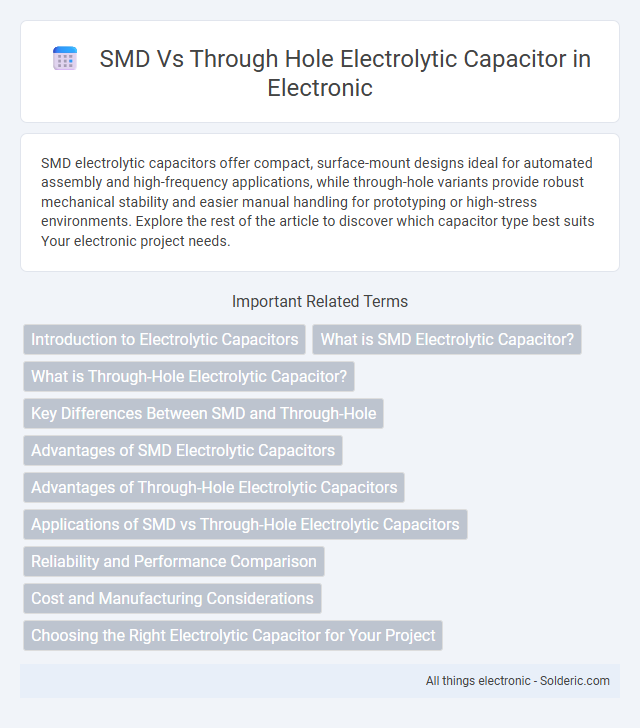SMD electrolytic capacitors offer compact, surface-mount designs ideal for automated assembly and high-frequency applications, while through-hole variants provide robust mechanical stability and easier manual handling for prototyping or high-stress environments. Explore the rest of the article to discover which capacitor type best suits Your electronic project needs.
Comparison Table
| Feature | SMD Electrolytic Capacitor | Through Hole Electrolytic Capacitor |
|---|---|---|
| Mounting Type | Surface Mount Device (SMD) | Leaded, through PCB holes |
| Size | Compact, low profile | Larger, bulkier |
| Assembly | Automated pick and place | Manual or wave soldering |
| Electrical Performance | Lower ESR, better high-frequency response | Higher ESR, less optimal for high frequencies |
| Reliability | Good, depends on PCB design and soldering | Robust, mechanical stability due to leads |
| Cost | Typically higher per unit | Generally lower cost |
| Applications | Compact consumer electronics, mobile, RF circuits | Industrial, power supplies, audio equipment |
Introduction to Electrolytic Capacitors
Electrolytic capacitors store energy using an electrolyte, offering high capacitance in compact sizes essential for power supply filtering and decoupling applications. Surface-mount device (SMD) electrolytic capacitors provide space-saving advantages and better performance at high frequencies, while through-hole versions offer mechanical stability and higher voltage ratings. Your choice depends on circuit requirements, balancing size, capacitance, and mounting preferences.
What is SMD Electrolytic Capacitor?
An SMD electrolytic capacitor is a surface-mounted device designed for compact electronic circuits, providing high capacitance in a small footprint. Unlike through-hole capacitors, SMD types are soldered directly onto the PCB surface, enabling automated assembly and improved manufacturing efficiency. These capacitors are commonly used in applications requiring low ESR and stable performance at higher frequencies.
What is Through-Hole Electrolytic Capacitor?
Through-hole electrolytic capacitors are polarized components designed for high capacitance values and reliability, featuring leads that pass through PCB holes for secure mounting and better mechanical stability. These capacitors typically offer higher voltage ratings and larger physical sizes compared to surface-mount devices (SMD), making them suitable for power supply filtering and audio applications. Their radial or axial lead configurations allow for robust solder joints, ensuring durability in high-stress environments.
Key Differences Between SMD and Through-Hole
SMD electrolytic capacitors are smaller, surface-mounted components designed for automated assembly, offering higher density on PCBs and better performance at high frequencies. Through-hole electrolytic capacitors have longer leads for insertion into PCB holes, providing stronger mechanical bonds and ideal for applications requiring higher voltage and current ratings. Your choice depends on space constraints, manufacturing processes, and electrical requirements of the circuit.
Advantages of SMD Electrolytic Capacitors
SMD electrolytic capacitors offer significant advantages including their compact size, which enables high-density circuit designs and automated assembly processes. Their low equivalent series resistance (ESR) improves performance in high-frequency applications and reduces power loss. Additionally, SMD capacitors enhance mechanical reliability due to surface mounting, minimizing lead-related failures compared to through-hole counterparts.
Advantages of Through-Hole Electrolytic Capacitors
Through-hole electrolytic capacitors offer superior mechanical stability due to their leads passing through the PCB, making them ideal for high-vibration environments. They typically provide higher capacitance values and voltage ratings compared to SMD capacitors, supporting demanding power supply applications. Their ease of manual assembly and inspection enhances reliability in prototyping and repair scenarios.
Applications of SMD vs Through-Hole Electrolytic Capacitors
SMD electrolytic capacitors are commonly used in compact electronic devices such as smartphones, laptops, and wearable technology due to their small size and suitability for automated PCB assembly. Through-hole electrolytic capacitors are preferred in applications requiring higher capacitance values and better mechanical stability, such as power supplies, industrial equipment, and audio amplifiers. The choice between SMD and through-hole capacitor types depends on space constraints, mounting method, and electrical performance requirements in the application.
Reliability and Performance Comparison
Surface-mount device (SMD) electrolytic capacitors offer higher reliability in automated assembly due to reduced solder joint issues compared to through-hole types, resulting in improved long-term performance. SMD capacitors typically exhibit lower equivalent series resistance (ESR) and inductance, enhancing their efficiency in high-frequency applications, whereas through-hole capacitors provide greater mechanical stability in environments with significant vibrations. Your choice between these capacitor types can significantly impact circuit durability and performance based on the operating conditions and design requirements.
Cost and Manufacturing Considerations
SMD electrolytic capacitors typically offer lower manufacturing costs due to automated assembly processes and smaller package sizes, reducing material usage and board space. Through-hole capacitors require manual or semi-automated insertion, increasing labor and production time, which raises overall costs. Your choice depends on balancing cost-efficiency with design requirements and manufacturing capabilities.
Choosing the Right Electrolytic Capacitor for Your Project
Selecting the right electrolytic capacitor for your project depends on factors like board space, performance requirements, and assembly methods. SMD electrolytic capacitors offer a compact size and compatibility with automated surface-mount technology, ideal for high-density PCB designs, while through hole capacitors provide robust mechanical stability and are preferred for prototyping or high-stress environments. Evaluating voltage rating, capacitance tolerance, and ripple current specifications ensures optimal capacitor performance tailored to your project's electrical and physical constraints.
SMD vs through hole electrolytic capacitor Infographic

 solderic.com
solderic.com